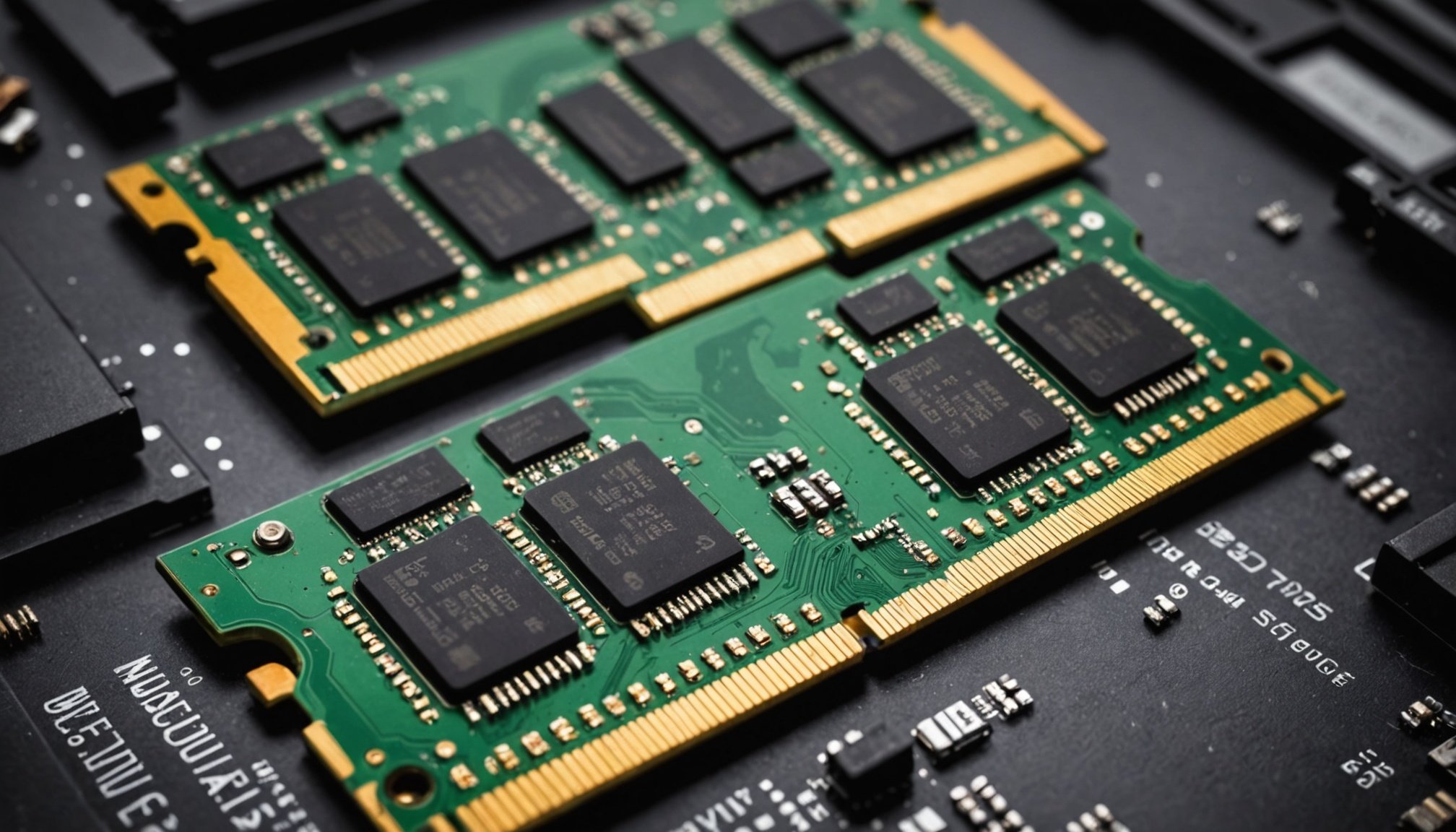Choosing the Perfect RAM Size for Your Needs: A Comprehensive Guide
When it comes to building or upgrading your computer, one of the most crucial components to consider is the RAM (Random Access Memory). RAM plays a vital role in your system’s performance, and choosing the right amount and type can make a significant difference in how your computer handles various tasks. Here’s a detailed guide to help you make the best decision for your needs.
Understanding Your RAM Needs
Before diving into the specifics, it’s essential to understand what you will be using your computer for. Different tasks require different amounts of RAM.
This might interest you : Ultimate Handbook for Enhancing Lenovo ThinkStation P620 Performance: A Step-by-Step Guide to Adding More RAM
For Basic Use
If you’re only using your computer for basic tasks like browsing the web, checking email, and working on documents, 8GB of RAM is usually sufficient. However, this minimum can quickly become inadequate if you start to multitask or use more resource-intensive applications[3].
For Gaming
Gaming is one of the most RAM-intensive activities you can engage in on your computer. For a smooth gaming experience, you’ll want at least 16GB of RAM. However, if you’re into high-resolution gaming (2K or 4K) or if you also stream your gameplay, 32GB or more is highly recommended[2][3].
Additional reading : Exploring the benefits: why choose m.2 nvme ssds instead of traditional sata ssds?
For Video Editing and Other Resource-Intensive Tasks
If you’re into video editing, 3D modeling, or any other resource-intensive tasks, you’ll need even more RAM. A minimum of 16GB is a good starting point, but 32GB or more is often necessary to ensure smooth performance. For professional-grade work, even 64GB or more might be required[1][3].
How Much RAM Do You Really Need?
Here’s a detailed breakdown of the RAM capacities and their typical uses:
-
4GB: This is the bare minimum for basic tasks and is not recommended for any serious use.
-
Suitable for: Very old systems or extremely basic use.
-
Not recommended for: Any form of gaming, video editing, or multitasking.
-
8GB: This is a good starting point for general use but can be limiting for more intensive tasks.
-
Suitable for: Basic office work, web browsing, and light multitasking.
-
Not recommended for: Gaming, video editing, or running multiple resource-intensive applications.
-
16GB: This is the minimum recommended for gaming and other resource-intensive tasks.
-
Suitable for: Gaming, video editing, and running multiple applications simultaneously.
-
Not recommended for: High-resolution gaming, heavy video editing, or professional-grade work.
-
32GB: This is ideal for heavy users who need to run multiple resource-intensive applications at once.
-
Suitable for: High-resolution gaming, heavy video editing, streaming, and professional-grade work.
-
Not recommended for: Basic users who only need to perform light tasks.
-
64GB and Above: This is for extreme users who need the maximum amount of RAM for very demanding tasks.
-
Suitable for: Professional video editing, 3D modeling, and other highly resource-intensive tasks.
-
Not recommended for: General users who do not need such high capacities[1][2][3].
Choosing the Right RAM Speed
RAM speed, measured in MHz, is another critical factor to consider. Here’s what you need to know:
DDR4 vs DDR5
- DDR4: This is the older but still widely used technology. For DDR4, speeds of 3200MHz to 3600MHz are common and sufficient for most users. However, if you’re looking for better performance, you can opt for higher speeds up to 3733MHz[3].
- DDR5: This is the newer technology that offers higher speeds and better performance. For DDR5, speeds of 5000MHz and above are recommended for optimal performance. However, DDR5 is still more expensive and less widely available than DDR4[2][3].
Frequency and Performance
The frequency of your RAM directly impacts its performance. Here’s a simple rule: the higher the frequency, the better the performance.
- For DDR4: Aim for at least 3200MHz for general use and 3600MHz or higher for gaming and other intensive tasks[3].
- For DDR5: Aim for 5000MHz or higher to get the most out of your system[2].
Dual Channel and Beyond
Using RAM in dual channel configuration can significantly improve performance. Here’s why:
What is Dual Channel?
Dual channel RAM configuration involves using two or more RAM modules of the same capacity and speed, installed in specific slots on your motherboard. This setup allows the RAM to work in tandem, increasing the data rate and improving overall system performance[3].
Benefits of Dual Channel
- Improved Performance: Dual channel configuration can increase the data rate, making your system faster and more efficient.
- Better Multitasking: With dual channel RAM, you can run multiple applications simultaneously without a significant drop in performance.
Example
If you’re building a gaming PC, using two 16GB DDR4 RAM modules in dual channel configuration (totaling 32GB) would be more efficient than using a single 32GB module[2].
Understanding RAM Timings and CAS Latency
RAM timings, particularly CAS (Column Address Strobe) latency, are important factors to consider when choosing your RAM.
What is CAS Latency?
CAS latency is the time it takes for the RAM to respond to a command. Lower CAS latency means faster RAM.
- Example: A RAM module with a CAS latency of 16 is faster than one with a CAS latency of 18[3].
Compatibility with Your Motherboard
Ensuring that your RAM is compatible with your motherboard is crucial.
Factors to Consider
- Capacity and Speed: Check your motherboard’s specifications to see the maximum RAM capacity and speed it supports.
- Type of RAM: Ensure that your motherboard supports the type of RAM you are using (DDR4 or DDR5).
- Slots and Configuration: Make sure you have the right number and type of slots for your RAM configuration (e.g., dual channel)[5].
Practical Tips for Upgrading Your RAM
Upgrading your RAM can be a straightforward process if you follow these tips:
Step-by-Step Guide
- Identify Your Motherboard: Check your motherboard manual or online specifications to see what type and amount of RAM it supports.
- Choose the Right RAM: Select RAM modules that match your motherboard’s specifications and your performance needs.
- Install the RAM: Insert the RAM modules into the correct slots, ensuring they are securely seated.
- Enable XMP Profiles: If your RAM supports XMP (eXtreme Memory Profile), enable it in your BIOS to get the maximum performance out of your RAM[3].
Real-World Examples and Anecdotes
Gaming Performance
For gamers, the right amount of RAM can make a significant difference. For example, playing games like “Cyberpunk” or “Call of Duty: Warzone” on ultra settings requires at least 16GB of RAM to avoid lag and stuttering. Adding more RAM, such as 32GB, can ensure a smoother experience even with multiple applications running in the background[4].
Video Editing
For video editors, having enough RAM is crucial for smooth performance. Using 32GB or more of RAM can significantly reduce rendering times and make the editing process much more efficient. For instance, using 64GB of RAM can handle 4K video editing with ease, making it a worthwhile investment for professionals[1].
Choosing the right RAM for your needs involves several key considerations: the amount of RAM, the speed, the type (DDR4 or DDR5), and ensuring compatibility with your motherboard. Here’s a summary to help you make the best decision:
Summary Table
| Use Case | Recommended RAM Capacity | Recommended RAM Speed | Type of RAM |
|---|---|---|---|
| Basic Use | 8GB | 3200MHz (DDR4) | DDR4 |
| Gaming | 16GB | 3600MHz (DDR4) / 5000MHz (DDR5) | DDR4 or DDR5 |
| Video Editing | 32GB | 3600MHz (DDR4) / 5000MHz (DDR5) | DDR4 or DDR5 |
| Professional | 64GB+ | 3733MHz (DDR4) / 6000MHz (DDR5) | DDR4 or DDR5 |
Final Tips
- Always Check Compatibility: Ensure your RAM is compatible with your motherboard.
- Use Dual Channel: For better performance, use RAM in dual channel configuration.
- Choose the Right Speed: Higher speeds generally offer better performance.
- Consider Future Needs: If you plan to upgrade your system in the future, choose RAM that will still be relevant.
By following these guidelines, you can ensure that your computer has the right amount and type of RAM to handle all your tasks efficiently, whether you’re a gamer, a video editor, or just a general user looking to upgrade your system.





